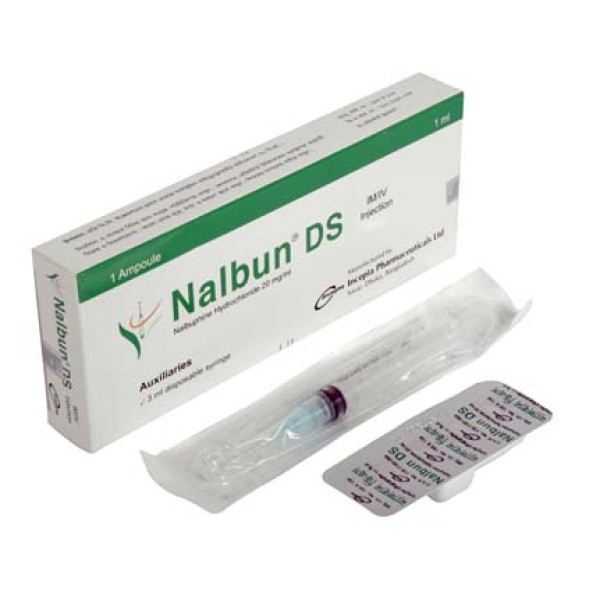
- Stock: In Stock
- Brand: Incepta Pharmaceuticals
- Product ID: Nalbuphine Hydrochloride
100% Secure Payment

Nalbun DS Injection 1ml
Description
Nalbuphine Hydrochloride is a synthetic opioid analgesic, which binds with mu, kappa and delta receptor. Its analgesic potency is equivalent to Morphine on a milligram basis and 10 times more than that of Pentazocine but has lower side effects and less abuse potential than Morphine. The onset of action of Nalbuphine occurs within 2 to 3 minutes after intravenous administration and in less than 15 minutes following intramuscular injection. The plasma half-life of Nalbuphine is 5 hours and the duration of analgesic activity is 3 to 6 hours.
Indications
Relief of moderate to severe pain associated with myocardial infarction (MI)
As a supplement of balanced anesthesia
Pre-operative and post-operative analgesia
Obstetrical analgesia during labor and delivery
Dosage & Administration
Moderate to severe pain: by intravenous or intramuscular injection 10-20 mg for 70 kg patient, adjusted
as required. Child up to 0.3 mg/kg repeated once or twice as necessary.
In balanced anesthesia: by intravenous or intramuscular injection 0.1-0.2 mg/kg.
Obstetrical analgesia during labor and delivery: by intravenous injection 0.3-1 mg/kg over 10-15 minutes with maintenance dose of 0.25-0.5 mg/kg in single intravenous administration as required.
Intra-operative analgesia: by intravenous injection 0.25-0.5 mg/kg at 30 minutes intervals.
Myocardial infarction: by slow intravenous injection 10-20 mg repeated after 30 minutes if necessary. Larger dose is required when used as supplement of anesthesia than that required for analgesia.
Children from 18 months to 15 years old: usually 0.2 mg/kg body-weight, given preferably by
intravenous or intramuscular injection. Maintenance doses may be given at intervals of 4 to 6 hours or the
dose must be determined by the physician.
Side Effects
Generally Nalbuphine is well tolerated. However few side-effects like sedation, sweating, nausea, vomiting, dizziness, vertigo, dry mouth, headache, respiratory depression, dyspnea and asthma may be seen.
Precautions
Caution should be taken in the following conditions: impaired respiration, impaired renal or hepatic function, billiary tract surgery, myocardial infarction and hypotension.
Use in Pregnancy & Lactation
Nalbuphine is pregnancy category B. The placental transfer of Nalbuphine is high and rapid. There are no adequate and well-controlled studies in pregnant women. This drug should be used during pregnancy only if clearly needed.
Less than 1% of the administered dose is excreted in milk. However cautions should be exercised when Nalbuphine is administered to a nursing mother.
Over Dose
The immediate intravenous administration of an opiate antagonist such as Naloxone or Nalmefene is a specific antidote. Oxygen, intravenous fluids, vasopressors and other supportive measures should be used as indicated. Sleepiness and mild dysphoria may occur due to overdose.






























